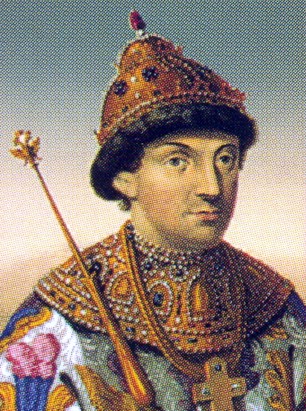History of Russia
Heads of the stateTHE ROMANOVS
Tsar Fedor II (1661-1682)
 Reign
1676-1682.
Reign
1676-1682.Wifes:
Agatha Semenovna Grushetskaya, the daughter of a waywode called Semyon Grushetsky.
Married: 1680.
Maria Matveevna Apraxina, daughter of a notary called Matvei Vasilyevich Apraxin.
Married: 14 February 1681.
Important events:
- 1677 - Founding of the Slavonic, Greek and Latin Academy in Moscow.
- 1678 - General census of the population.
- 1679 - Abolition of practice of mutilation.
- 1681 - signing of peace treaties with Turkey and the Crimea (1681). Turkey recognises Kiev as a Russian town and is awarded the Trans-Dnieper region.
- 1682 - The boyars were no longer kept by the local population. Promotion to government posts depended on the tsar's personal opinion, rather than birth
Fedor was born in Moscow on 30 May 1661 and crowned in the Dormition Cathedral on 18 June 1676. Educated by a monk called Simeon Polotsky, he knew Polish and Latin and was interested in painting, literature and music. He helped to design the Lesser Palace in the Moscow Kremlin, St. Alexis's Church in the Monastery of the Miracle and palace in the village of Vorobyovo.
To combat religious schismatics, Fedor planned to create an inquisition based on the West European model, but did not live to do so.
Following the example of Kiev, a Slavonic, Greek and Latin Academy was opened in Moscow, where young people could receive a byzantine education. The first multiplication table was printed in Russia.
Fedor suffered from poor health after falling off a horse at the age of twelve. He was unable to put on his own hat and could only walk with the aid of a stick. Like his father, he suffered from scurvy and had a mild disposition, earning him the sobriquet "Fedor the Most Meek". Although the tsar disliked unnecessary ceremony, he was a stickler for order. He liked animals, opening a menagerie at Voskresenskoe and stud farms in other royal villages. The sickly young tsar was under the sway of Ivan Yazykov and Alexei Likhachev - two members of non-aristocratic families. In 1680, they married him to Agatha Grushetskaya, the daughter of a waywode called Semyon Grushetsky. The following year, she died giving birth to a still-born son called Ilya. In the short time that they were married, Fedor was hopelessly dominated by Agatha, who supported the opening of Polish and Latin school in Moscow and the shaving of beards. Less significant events include the reform of the court dress, replacing Russian caftans with Western clothes. The streets of Moscow were repaired and new houses were built of stone.
The tsar remarried on 14 February 1682. This time, his choice fell on one of Ivan Yazykov's relatives - the seventeen-year-old Maria Apraxina, daughter of a notary called Matvei Apraxin.
Fedor II died in Moscow on 27 April 1682, two months after he married his second wife and one month before his twenty-first birthday. He was buried in the Archangel Cathedral. The tsar did not leave any surviving issue.
On our pages you can make the travel to history Russia , and to the history Moscow and S-Petersburg
recommended
sites:
 Internet
shop
of exclusive Russian souvenirs "ATAMAN".
Internet
shop
of exclusive Russian souvenirs "ATAMAN".
If you want to present a special gift to your relatives or friends,
want to get really unforgettable memory about your trip or you are
interested in the history of Russia - this shop is a real find for you
There are history maps, books, souvenirs, insignia, heraldry and many
other things on this site. This site have the English
version.
You can find the link for it in the right top corner of the site
We hope that the information of our portal will be useful to you.
